| |
|
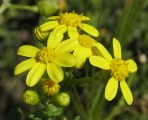 | |
| MaltaWildPlants.com by Stephen Mifsud |

|
| |
|
|
 |  |  |  |
| External Links: |
|
Papaver hybridum (Rough poppy) |

Papaver hybridum (PAPAVERACEAE.)
Images for this profile are taken from the Maltese Islands after year 2000. |
|
| Nomenclature |
Species name : | Papaver hybridum L. | Authority : | Carl von Linne, Sweden, (1707 - 1778) | Synonyms :
(basionym or principal syn.) |
|
Plant Family : | | English name(s) : | Rough poppy | Maltese name(s) : | Peprin tal-Lanzit | Status for Malta : | Indigenous. Present on the Maltese islands before man | Name Derivation : |
Papaver: Latin name for poppy, probably derived from the Latin pappa meaning food or milk, and hence with reference to the milky sap of plants belonging to this genus. (Latin origin ); 2 = Latin name for poppy, also "pappa" is the Latin for food or milk, referring to the milky sap of the plant (Latin).
hybridum: related or originating from a hybrid, hence a species from two genetically-mixed parents. (Latin origin ); 2 = hybrid form, genetically mixed species (Latin).
| Remarks : | |
|
| Morphology and structure |
PLANT STRUCTURE: |
Character | Growth Form | Branching | Surface |
Description | | | |
General
Picture |  |  |  |
|
LEAVES: |
Character | Arrangement | Attachment | Venation |
Description | | | |
General
Picture |  | 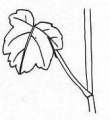 |  |
| |
Character | Leaf Shape | Leaf Margin | Remarks |
Description | | | |
General
Picture |  |  |  |
|
FLOWERS: |
Character | Colour | Basic Flower Type | No. of Petals | No. of Sepals |
Description | Crimson Red | | 4 | 2 |
General
Picture | | 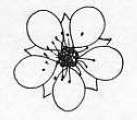 |  |  |
| |
Character | Inflorescence | Description | Ovary | Stamens |
Description | | Flower is made up of 4 crimson-red, petals with a black spot at its base. The petals do not overlap each other. There is a central globular ovary with numerous indigo or pale blue stamens at its periphery. The 2 hairy sepals fall off when flower opens up. | | |
General
Picture |  |  | 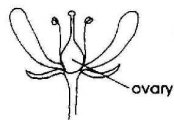 |  |
| |
Character | Scent | Average Flower Size | Pollen Colour | Other Notes |
Description | None | 18-30mm | Indigo to Pale Blue Pollen colour is very contrasting with the flower. | - |
|
SEEDS: |
Character | No. Per Fruit | Shape | Size | Colour |
Description | >200 Numerous tiny seeds which ther quantity varies according to the fruit size. | Reniform Small, kidney-shaped seeds; rather swollen. | Not more from 1mm | Dark gray |
General
Picture |  |  |  |  |
|
FRUIT AND OTHER BOTANICAL DATA: |
Character | Fruit Type | Colour of Fruit | Subterranean Parts | Other Notes |
Description | | Dark Green (turns brown when fully ripe). | | - |
General
Picture | 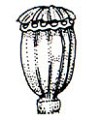 |  |  |  |
|
|
| Plant description and characters | |
Life Cycle: | Annual. |
Growth Form: | THEROPHYTE (annual plants, herbaceous) |
Habitat: | Fields, waysides, weedy waste-ground. |
Frequency: | Frequent |
Localities in Malta: | Found in few scattered numbers in several fields such as in Mistra, Pieta', Qormi and Bahrija. |
Plant Height: | 10-50cm. |
| Mar-May |
Protection in Malta: | Not legally protected till the last update of this website (2/Mar/2022) |
Red List 1989: | Not listed in the Red Data Book of the Maltese Islands |
Poison: | |
Like most poppies, the rough poppy is an erect annual plant with large bright coloured, single, terminal flowers. The name rough comes from the fact that the seed capsule possess white stiff bristles. Those of the calyx are not so stiff, while those of the stem and leaves further more soft. The main stem branches into few stems at the lower part of the plant and give rise to one single flower.
The leaves are mulit pinnately lobed (pinnatifid) and can reach up to 10cm in length, but normally they are about 6-7 cm. Leaves grow alternately along stem and have have little hair.
The flower bud has an upside-down peduncle and made up of 2 bristly sepals. On blossoming, the flower takes an erect position and the sepals falls. The corolla is rather small (2-5cm) in comparison to other wild poppy flowers and consists of 4 crimson-red petals with a dark purple-black blob at the base. The petals are relatively narrow and rarely overlap when fully mature. A distinctive feature of this poppy is the indigo or pale blue colour of the numerous anthers around the central ovary (carpel). The ovary have about 6 to 8 radiating striped stigmas at the top usually coloured in indigo or violet.
The seed-pod is globular or slightly oval in shape and is covered with stiff bristles. When it dries it forms a indehisicate operculate (having a lid structure) capsule which holds many tiny kidney-shaped seeds which escape out through tiny slits in the upper part of the capsule (at the 'lid') when the stem sways with wind.
|
|
| Information, uses and other details |
Personal Observations
The plant can be mistaken with a similar poppy species - the Papaver argemone. It also have hair and forms a rather small flower. The main differences is that P. argemone have a scarlet red flowers (instead crimson) and more important, the seed capsule is well elongated (rather than spherical) and less bristly .[SM]
The petals of the plant are very fragile, and they drop off with little stress such as by wind or light shaking of the stem. It is more successful to find the flowers in the morning, just after blossoming, rather in the afternoon since the wind currents during the day may cause the petals to fall. In fact it is useless to cut these flowers to study them at the Lab or studio, because the petals will drop off during cutting or while transporting . [SM]
This poppy is not common in Malta and is rarely found growing on its own. However there is a good chance to be found amongst other common poppies (namely P. rhoeas ) since usually it will be present in mixed communities of poppies. [SM]
Not much information has been found about this particular plant species. If you can supply further info to be included in this profile, please do not hesitate to email us pr by using the form found at the botom of this page. Full reference credits will be given accordingly. Thank you for your support!
|
|
| Links & Further literature
(0 papers) |

Google Web |

Google Images |

Google Scholar |

Research Gate |

Wikipedia |

JSTOR |

GBIF |

Med Checklist |

Cat. of Life |

EoL |

IPNI |

World Flora Online |

Plants of the World Online |

Vienna Virt. Herb. |

RBGE Herbarium |

KEW Herbarium |

MNHN |

Arkive |

IUCN |

CABI |
Kindly Email if there are papers and publications about local
studies or information about this species to be included in the list above.
|
| Photo Gallery (26 Images) | 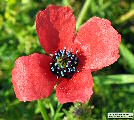 |
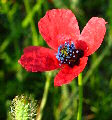 |
 |
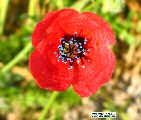 |
IMAGE: PPVHY-01 Photo of flower having non overlapping (or sometimes marginally overlapping) crimson/red petals. |
IMAGE: PPVHY-02 Close up photo of flower showing its anthers with their characteristic light indigo-blue colour, held by upright purple/black filaments. |
IMAGE: PPVHY-03 Side-view photo of the flower of Papaver hybridum . |
IMAGE: PPVHY-04 Photo of flower showing cluster of stamens around a central oval ovary, overtopped with 6-7, dark purple, linear stigmata. |
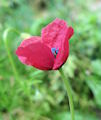 |
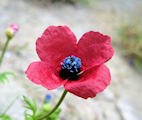 |
 |
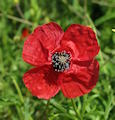 |
IMAGE: PPVHY-05 Photo of a young flower, with its petal forming a cup-shaped structure. When mature, the petals open up forming a flattened flower-shape. |
IMAGE: PPVHY-06 Photo of a mature flower. The colour of the flowers differs slightly from that of the common poppy (Papaver rhoeas) - it is more crimson (purplish) in this species (Papaver hybridum), and 'pure-red' in the common poppy. |
IMAGE: PPVHY-07 Photo of flower and fruit capsule. |
IMAGE: PPVHY-08 Photo of a typical flower with 4, large, slightly pleated, crimson-red petals with a small black blob at the base. |
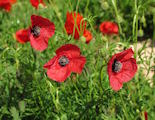 |
 |
| | IMAGE: PPVHY-09 Photo of several flowers decorating our countryside in March and April. |
IMAGE: PPVHY-10 Photo of a bud, mature flower and fruit capsule (top right) of this species. |
IMAGE: PPVHY-11 - |
IMAGE: PPVHY-12 - |
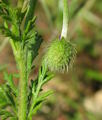 |
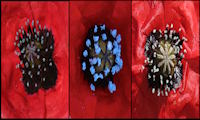 |
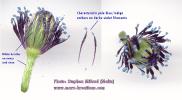 |
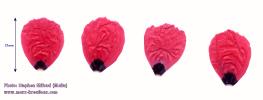 |
IMAGE: PPVHY-13 Photo of bud covered with long bristles, somewhat softer and more dense than those of the fruit. |
IMAGE: PPVHY-14 Close up photo of the cluster of stamens with their characteristical pale blue anthers of 3 specimens. Colour varies between different specimens, but also due to different light conditions (shade/sunlight). |
IMAGE: PPVHY-15 Scanned image of a dissected flower showing the pale blue/indigo anthers on dark purple filaments. Bristles also present on ovary during the flower stage. |
IMAGE: PPVHY-16 Crimson red petals (21mm length) with a black, rather small spot at the base of the petal. |
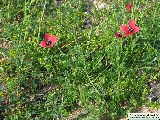 |
 |
 |
 |
IMAGE: PPVHY-17 Photo of whole plant in situ. |
IMAGE: PPVHY-18 Photo of plant in situ showing the bristly bud and seed capsule. |
IMAGE: PPVHY-19 Photo of a solitary plant in situ showing leaves, stem and a flower. |
IMAGE: PPVHY-20 Scanned image of plant. |
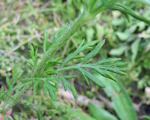 |
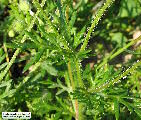 |
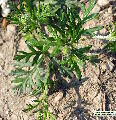 |
 |
IMAGE: PPVHY-21 Photo of the pinnatifid leaf, made up several branching linear segments. |
IMAGE: PPVHY-22 Close up photo of the pinnatifid leaves in situ. They are not present along the flowering stem. |
IMAGE: PPVHY-23 Close up photo of leaves and buds in situ. Note the black tips of the leaf lobes. |
IMAGE: PPVHY-24 Scanned image of the leaf. |
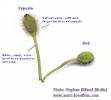 |
 |
 |
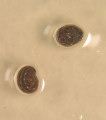 |
IMAGE: PPVHY-25 Scanned image of a seed capsule and a bud. The bristles of the capsule are more stiff and slightly larger from those on the rest of the plant. |
IMAGE: PPVHY-26 Close up photo of fruit which is an operculate poricidal capsule. Unlike that of the common poppy (Papaver rhoeas), the fruit is covered with stiff bristles. |
IMAGE: PPVHY-27 Close up photo of fruit capsule in situ, where this particular one have an interesting violet stigma. |
IMAGE: PPVHY-28 Photo of image of seeds under microscope. Note the texture of the seed coat and the kidney-like shape. |
|
| | |

